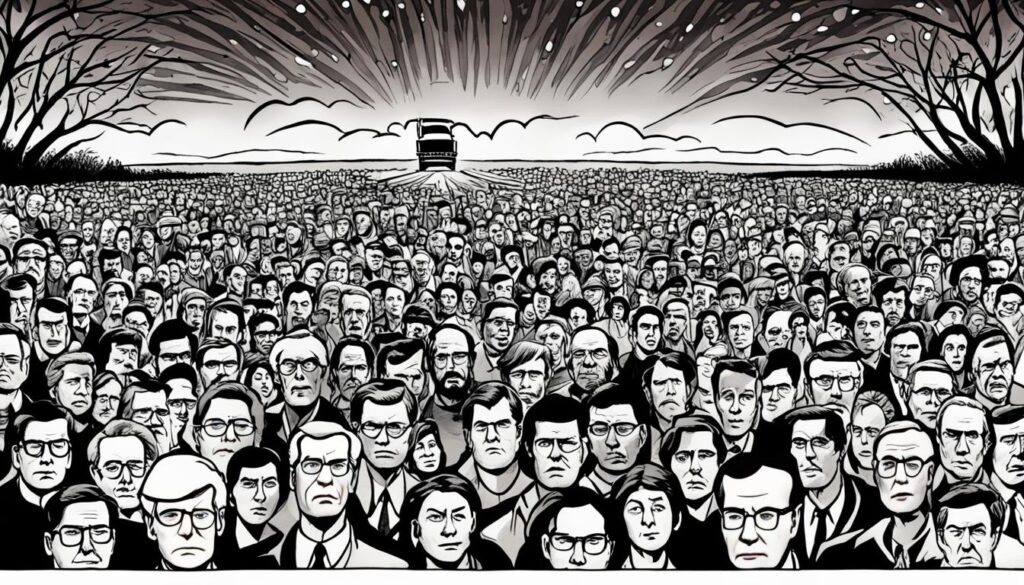Are you a fan of Stephen King and wondering what order to read his books in? Look no further! This comprehensive guide will provide you with the optimal reading order for Stephen King books. Whether you’re new to King’s works or a long-time fan, this guide will help you navigate through his vast collection of novels.
Stephen King has published over 60 books spanning various genres, including horror, mystery, and science fiction. With so many books to choose from, it can be overwhelming to decide where to start. That’s where this guide comes in – we’ve done the research and put together a suggested reading order that will enhance your reading experience.
Key Takeaways:
- A comprehensive guide to the optimal reading order for Stephen King books
- Provides a suggested sequence for reading King’s works to enhance the reading experience
- Covers the chronological order of novels, as well as specific series and standalone novels
- Guides readers on where to start with Castle Rock and Bachman books
- Concludes by emphasizing that the suggested reading order is optional, and readers should feel free to read the books in the sequence that best fits their preferences
Chronological Order of Stephen King’s Novels
For readers who prefer to experience Stephen King’s writing as he intended, following the chronological order of his works provides an immersive journey through the evolution of his writing style and storytelling. The chronological order of Stephen King’s books follows their release dates, beginning with his debut novel Carrie in 1974 and concluding with The Institute in 2019.
“Life is like a wheel. Sooner or later, it always come around to where you started again.” – Stephen King, The Gunslinger
Reading the novels in the order they were published also allows for contextual understanding of the pop culture and societal trends that influenced King’s work and the history of the publishing industry itself. However, this order may not necessarily be the best fit for those looking for a streamlined reading experience, as some of his earlier works may be stylistically different and less polished than his later novels. Nevertheless, undertaking this reading journey is a rewarding experience for any Stephen King fan wishing to delve deeper into the author’s extensive universe.
The Dark Tower Series: A Separate Reading Path
For fans of Stephen King, The Dark Tower series is a must-read. This fantasy epic weaves together elements from many of King’s other works, creating a rich and intricate universe that will keep readers engrossed from start to finish.
While the books can be read as a standalone series, they also contain many references and connections to other Stephen King novels. Therefore, it’s important to determine the right placement for this series in your reading order.
“The man in black fled across the desert, and the gunslinger followed.”
If you’re new to this series, the ideal starting point is The Gunslinger, the first book in the series. After that, fans should read The Drawing of the Three, The Waste Lands, and Wizard and Glass in that order. It’s important to note that Wizard and Glass is mostly a flashback prequel to the earlier books, so it’s important to read it after The Waste Lands.
After reading these four books, you can choose to read the remaining books either as part of the chronological order or return to The Dark Tower series as a separate reading path. If you decide on the latter option, the remaining books are Wolves of the Calla, Song of Susannah, and The Dark Tower.
By following this reading order, you’ll ensure that you don’t miss any of the connections between The Dark Tower series and other Stephen King books. Additionally, reading the series in this order will enhance your overall understanding and enjoyment of the series.
The Standalone Novels: Recommended Order
If you prefer to read Stephen King’s standalone novels rather than his series, we recommend starting with Carrie, King’s debut novel. This horror classic introduces readers to Carrie White, a teenage girl with telekinetic powers who is bullied and ultimately takes revenge on her peers.
Next, we suggest moving on to Salem’s Lot, which tells the story of a small town in Maine overrun by vampires. While this book can technically be considered part of the shared universe, it is best read as a standalone work.
After Salem’s Lot, we recommend reading The Shining, a psychological horror novel that features a haunted hotel and a man’s descent into madness. This novel is one of King’s most iconic works and has inspired numerous adaptations.
Following The Shining, readers should move on to The Stand, a post-apocalyptic novel that explores themes of good and evil in a world ravaged by a deadly pandemic. This novel is a fan favorite and contains many references to King’s other works.
Next on the list is It, a horror epic that spans multiple decades and tells the story of a group of friends battling an evil entity that takes on the form of a clown. This novel is also intricately connected to the wider Stephen King universe.
Finally, we recommend ending with 11/22/63, a time travel novel that explores what might have happened if someone had the chance to prevent the assassination of President John F. Kennedy. While not strictly a horror novel, 11/22/63 features elements of suspense and tension throughout.
Reading King’s standalone novels in this recommended order will allow readers to appreciate connections and references between the books, enhancing the overall reading experience.
The Bill Hodges Trilogy: Suggested Placement
Stephen King’s Bill Hodges trilogy consists of three novels: Mr. Mercedes, Finders Keepers, and End of Watch. These books feature retired detective Bill Hodges, who becomes entangled in a series of crimes committed by a notorious killer.
The Bill Hodges trilogy is set in the same universe as other Stephen King novels, and while it can be read on its own, it is recommended to read these books after finishing the Dark Tower series and before moving on to the Outsider and If It Bleeds.

The trilogy provides important character development and adds depth to the larger Stephen King universe, making it a valuable addition to any reading order. It also features familiar locations and connections to other Stephen King novels, making it an enjoyable reading experience for fans of his work.
The Castle Rock Novels: Where to Begin
If you’re interested in diving into Stephen King’s Castle Rock novels, it can be difficult to know where to start. The Castle Rock universe is vast, with numerous novels set in the fictional Maine town.
A great starting point is The Dead Zone, which introduces the town and some of its key characters. After that, Cujo and The Dark Half are solid choices to continue exploring the Castle Rock world.
It’s worth noting that while the Castle Rock novels can stand on their own, they also tie into other Stephen King works, such as the Dark Tower series and the Bill Hodges trilogy. Keep this in mind if you plan on reading all of King’s books in a specific order.
The Bachman Books: Reading Order
Stephen King wrote several novels under the pseudonym Richard Bachman. These books were originally published in the late 1970s and early 1980s and were later reissued under King’s name. The Bachman books have the same dark, horror themes as King’s other works and are often considered to be part of the Stephen King universe.
The recommended reading order for the Bachman books is:
- Rage (1977)
- The Long Walk (1979)
- Roadwork (1981)
- The Running Man (1982)
- Thinner (1984)
Reading the Bachman books in this order enhances the overall reading experience by providing a better understanding of King’s larger body of work. Rage introduces some of the themes and motifs that appear in later books, while The Long Walk and Roadwork offer different takes on the topic of societal control. The Running Man and Thinner are more action-packed, but contain deeper messages about moral responsibility and justice.
Incorporating the Bachman books into the overall Stephen King reading order is optional but can add another layer of depth to the reading experience.
Collaborations and Collections: Placement in the Reading Order
Stephen King has collaborated with several authors over the years, including Peter Straub, Joe Hill, and Richard Chizmar. While these books may not be considered part of the main Stephen King canon, they are still worth reading for fans who enjoy exploring his extended universe.
One notable collaboration is The Talisman, which King wrote with Peter Straub. The book follows a young boy on a quest to find a magical talisman that will save his mother’s life. It is set in a universe parallel to that of the Dark Tower series and features connections to other Stephen King works.
Another collaboration worth mentioning is Sleeping Beauties, which King co-wrote with his son, Joe Hill. The book takes place in a world where women have become cocooned in a mysterious substance, causing chaos among the remaining men. It tackles themes of gender and power and is a great addition to any Stephen King reading list.
In addition to collaborations, Stephen King has also released several collections of short stories. These can be read at any point in the reading order, but some stories do contain connections to other Stephen King works, such as The Body, which inspired the movie Stand By Me.
When it comes to including collaborations and collections in the reading order, it is up to personal preference. Some readers choose to read them in publication order, while others prefer to read them in between the main novels. Regardless of where they fit in the reading order, collaborations and collections are a great way to expand on the Stephen King universe and explore new stories and themes.
Conclusion
In conclusion, this guide provides an optimal reading order for Stephen King’s books, taking into account the chronological order, the Dark Tower series, standalone novels, the Bill Hodges trilogy, Castle Rock novels, the Bachman books, collaborations, and collections. However, it is important to note that readers can also choose to read the books in a different sequence based on personal preference.
Reading Stephen King’s books in the order suggested in this guide will enhance the overall reading experience, allowing readers to fully appreciate the connections and references between the different works. It provides a comprehensive view of Stephen King’s universe and the characters that inhabit it.
We hope this guide has been helpful in providing a clear understanding of the optimal reading order for Stephen King’s books. Happy reading!



